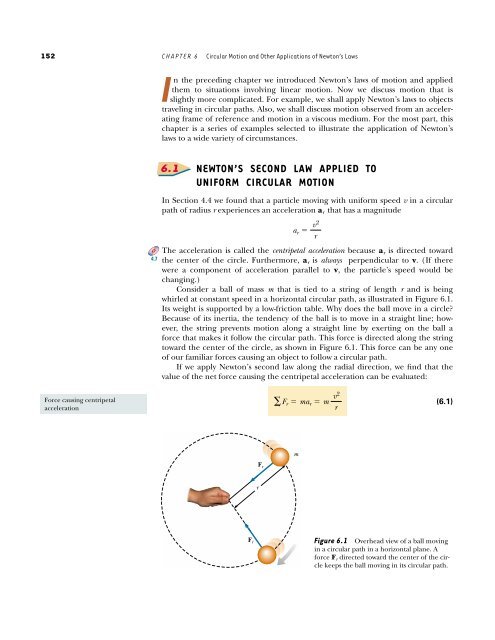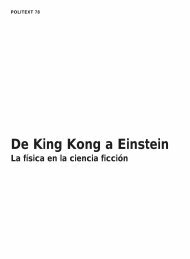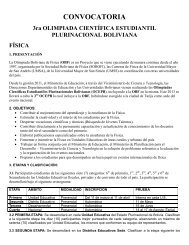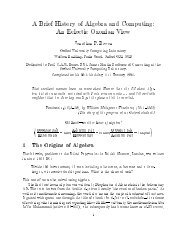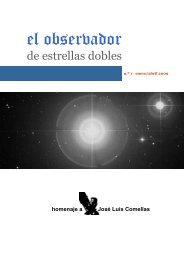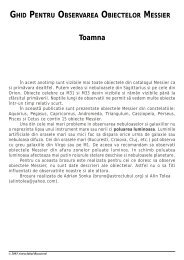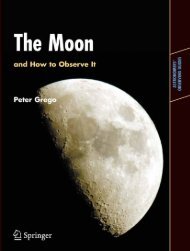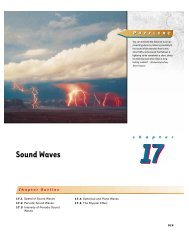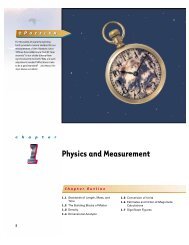Circular Motion and Other Applications of Newton's Laws
Circular Motion and Other Applications of Newton's Laws
Circular Motion and Other Applications of Newton's Laws
Create successful ePaper yourself
Turn your PDF publications into a flip-book with our unique Google optimized e-Paper software.
152 CHAPTER 6 <strong>Circular</strong> <strong>Motion</strong> <strong>and</strong> <strong>Other</strong> <strong>Applications</strong> <strong>of</strong> Newton’s <strong>Laws</strong><br />
Force causing centripetal<br />
acceleration<br />
4.7<br />
In the preceding chapter we introduced Newton’s laws <strong>of</strong> motion <strong>and</strong> applied<br />
them to situations involving linear motion. Now we discuss motion that is<br />
slightly more complicated. For example, we shall apply Newton’s laws to objects<br />
traveling in circular paths. Also, we shall discuss motion observed from an accelerating<br />
frame <strong>of</strong> reference <strong>and</strong> motion in a viscous medium. For the most part, this<br />
chapter is a series <strong>of</strong> examples selected to illustrate the application <strong>of</strong> Newton’s<br />
laws to a wide variety <strong>of</strong> circumstances.<br />
6.1<br />
NEWTON’S SECOND LAW APPLIED TO<br />
UNIFORM CIRCULAR MOTION<br />
In Section 4.4 we found that a particle moving with uniform speed v in a circular<br />
path <strong>of</strong> radius r experiences an acceleration a r that has a magnitude<br />
a r � v2<br />
r<br />
The acceleration is called the centripetal acceleration because a r is directed toward<br />
the center <strong>of</strong> the circle. Furthermore, a r is always perpendicular to v. (If there<br />
were a component <strong>of</strong> acceleration parallel to v, the particle’s speed would be<br />
changing.)<br />
Consider a ball <strong>of</strong> mass m that is tied to a string <strong>of</strong> length r <strong>and</strong> is being<br />
whirled at constant speed in a horizontal circular path, as illustrated in Figure 6.1.<br />
Its weight is supported by a low-friction table. Why does the ball move in a circle?<br />
Because <strong>of</strong> its inertia, the tendency <strong>of</strong> the ball is to move in a straight line; however,<br />
the string prevents motion along a straight line by exerting on the ball a<br />
force that makes it follow the circular path. This force is directed along the string<br />
toward the center <strong>of</strong> the circle, as shown in Figure 6.1. This force can be any one<br />
<strong>of</strong> our familiar forces causing an object to follow a circular path.<br />
If we apply Newton’s second law along the radial direction, we find that the<br />
value <strong>of</strong> the net force causing the centripetal acceleration can be evaluated:<br />
F r<br />
r<br />
F r<br />
�F r � ma r � m v2<br />
r<br />
m<br />
(6.1)<br />
Figure 6.1 Overhead view <strong>of</strong> a ball moving<br />
in a circular path in a horizontal plane. A<br />
force F r directed toward the center <strong>of</strong> the circle<br />
keeps the ball moving in its circular path.


